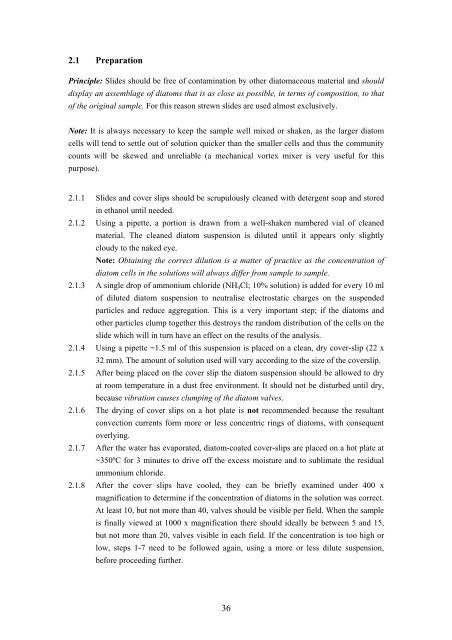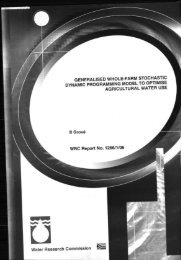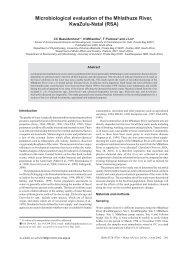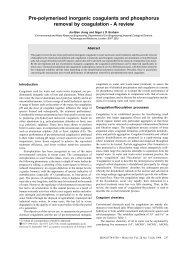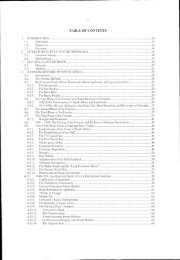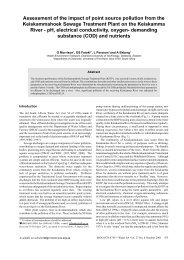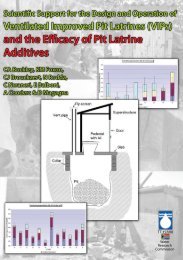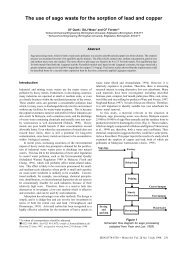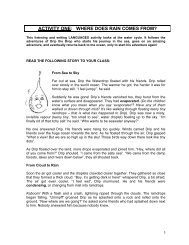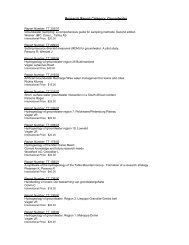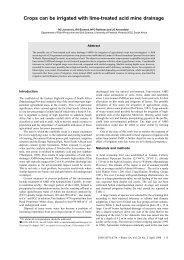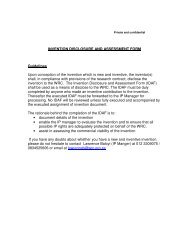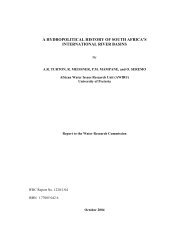A Methods Manual for the Collection, Preparation and Analysis of ...
A Methods Manual for the Collection, Preparation and Analysis of ...
A Methods Manual for the Collection, Preparation and Analysis of ...
Create successful ePaper yourself
Turn your PDF publications into a flip-book with our unique Google optimized e-Paper software.
2.1 <strong>Preparation</strong>Principle: Slides should be free <strong>of</strong> contamination by o<strong>the</strong>r diatomaceous material <strong>and</strong> shoulddisplay an assemblage <strong>of</strong> diatoms that is as close as possible, in terms <strong>of</strong> composition, to that<strong>of</strong> <strong>the</strong> original sample. For this reason strewn slides are used almost exclusively.Note: It is always necessary to keep <strong>the</strong> sample well mixed or shaken, as <strong>the</strong> larger diatomcells will tend to settle out <strong>of</strong> solution quicker than <strong>the</strong> smaller cells <strong>and</strong> thus <strong>the</strong> communitycounts will be skewed <strong>and</strong> unreliable (a mechanical vortex mixer is very useful <strong>for</strong> thispurpose).2.1.1 Slides <strong>and</strong> cover slips should be scrupulously cleaned with detergent soap <strong>and</strong> storedin ethanol until needed.2.1.2 Using a pipette, a portion is drawn from a well-shaken numbered vial <strong>of</strong> cleanedmaterial. The cleaned diatom suspension is diluted until it appears only slightlycloudy to <strong>the</strong> naked eye.Note: Obtaining <strong>the</strong> correct dilution is a matter <strong>of</strong> practice as <strong>the</strong> concentration <strong>of</strong>diatom cells in <strong>the</strong> solutions will always differ from sample to sample.2.1.3 A single drop <strong>of</strong> ammonium chloride (NH 4 Cl; 10% solution) is added <strong>for</strong> every 10 ml<strong>of</strong> diluted diatom suspension to neutralise electrostatic charges on <strong>the</strong> suspendedparticles <strong>and</strong> reduce aggregation. This is a very important step; if <strong>the</strong> diatoms <strong>and</strong>o<strong>the</strong>r particles clump toge<strong>the</strong>r this destroys <strong>the</strong> r<strong>and</strong>om distribution <strong>of</strong> <strong>the</strong> cells on <strong>the</strong>slide which will in turn have an effect on <strong>the</strong> results <strong>of</strong> <strong>the</strong> analysis.2.1.4 Using a pipette ~1.5 ml <strong>of</strong> this suspension is placed on a clean, dry cover-slip (22 x32 mm). The amount <strong>of</strong> solution used will vary according to <strong>the</strong> size <strong>of</strong> <strong>the</strong> coverslip.2.1.5 After being placed on <strong>the</strong> cover slip <strong>the</strong> diatom suspension should be allowed to dryat room temperature in a dust free environment. It should not be disturbed until dry,because vibration causes clumping <strong>of</strong> <strong>the</strong> diatom valves.2.1.6 The drying <strong>of</strong> cover slips on a hot plate is not recommended because <strong>the</strong> resultantconvection currents <strong>for</strong>m more or less concentric rings <strong>of</strong> diatoms, with consequentoverlying.2.1.7 After <strong>the</strong> water has evaporated, diatom-coated cover-slips are placed on a hot plate at~350ºC <strong>for</strong> 3 minutes to drive <strong>of</strong>f <strong>the</strong> excess moisture <strong>and</strong> to sublimate <strong>the</strong> residualammonium chloride.2.1.8 After <strong>the</strong> cover slips have cooled, <strong>the</strong>y can be briefly examined under 400 xmagnification to determine if <strong>the</strong> concentration <strong>of</strong> diatoms in <strong>the</strong> solution was correct.At least 10, but not more than 40, valves should be visible per field. When <strong>the</strong> sampleis finally viewed at 1000 x magnification <strong>the</strong>re should ideally be between 5 <strong>and</strong> 15,but not more than 20, valves visible in each field. If <strong>the</strong> concentration is too high orlow, steps 1-7 need to be followed again, using a more or less dilute suspension,be<strong>for</strong>e proceeding fur<strong>the</strong>r.36


